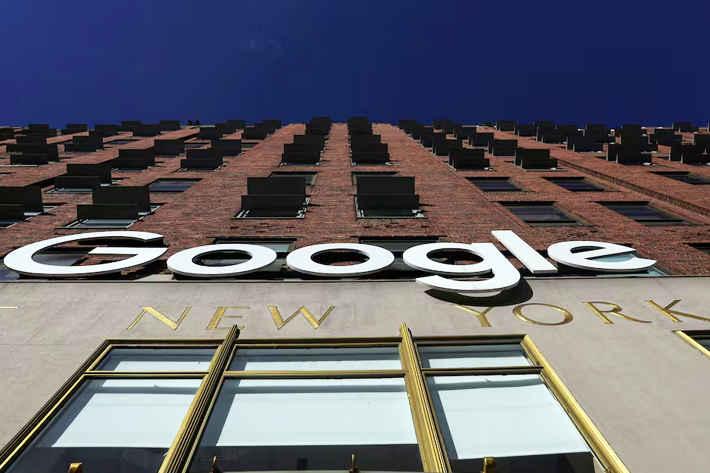Asset managers responsible for funds worth hundreds of billions of dollars have been pressing Microsoft, Alphabet and other Big Tech firms over their environmental impact, particularly from the AI boom.
The power demands of artificial intelligence and advanced computing have started to raise doubts among some investors over whether the sector should remain heavily represented in sustainable funds.
While these conversations are at an early stage, six fund industry executives in Europe and the United States said they are looking more closely at the environmental impact of artificial intelligence, which Goldman Sachs estimates will boost data centre power demand 160% by 2030.
None of the investors contacted by Reuters said they were considering divesting.
Also on AF: ‘Deepfake’ of Ukrainian Official Targets Top US Senator: NYT
Some of the biggest tech companies leading the AI race that requires building and powering data centres have started reporting increased greenhouse gas emissions, raising questions from asset managers who want to show their portfolios do well not only financially but also by the environment.
Tech’s thirst for power is likely to go unabated because AI and cloud computing are important drivers of growth, although many expect data centre efficiency to increase greatly.
Tech stocks became go-to picks for many such funds, because they made outsized market gains while producing fewer greenhouse gases than stocks in other sectors like manufacturing and energy.
Investments marketed with environmental, social and governance concerns in mind have lost some favour since a pandemic era boom.
But there are still some $2.24 trillion in equity in one of the strictest ESG categories: funds that come under Article 8 and 9 funds under the European Union’s financial law, according to data firm Morningstar Direct. There was almost $30 trillion in global equity funds held as of last year.
A review of the top holdings of the largest such funds shows they are now heavily invested in tech giants, including Apple, Amazon, Alphabet, Microsoft, Meta and Nvidia.
Some of those investments could be affected if the concerns are not addressed, the investors and analysts said.
“What we will do is make the AI angle a central part of our climate-related engagement with tech companies,” said Eric Pedersen, head of responsible investments at Nordea Asset Management.
If the companies were to loosen current commitments to source renewable energy now and in the future, managers may choose to exclude them from some of the more strictly-defined funds.
This would count against them achieving “sustainable investment” status, he said.
Tech Giants Quizzed on Energy Use
An Article 8 fund is meant to “promote … environmental or social characteristics” while an Article 9 fund “has sustainable investment as its objective,” EU rules say.
Pedersen called AI “one of the biggest potential shifts in the standard composition” of a sustainable fund.
“Where we have committed a proportion to sustainable investments in our internal ESG scoring, you might see it becoming harder for those companies to fulfil that,” he said.
Nordea’s $291.7 billion under management includes a total investment of about $18.96 billion in Microsoft, Amazon, Alphabet, Apple, NVIDIA and Meta shares.
Jason Qi, senior ESG research analyst for Morgan Stanley’s Calvert Research and Management, said he had been asking the firms for more information about current energy use.
Qi cited Microsoft as a leader in disclosing data like power supply deals (PPAs), but said no company was sharing as much as he wants.
“We are waiting for more details about their AI-related power consumption, the volume of their PPAs, the geographic distribution, the duration,” Qi said.
Investors are also starting to ask more questions about so-called Scope 3 emissions which emerge from the supply chain.
Microsoft, Amazon and Nvidia declined to comment. Meta, Alphabet, Apple and Tesla did not respond to requests for comment.
Meta Offsetting Emissions
The challenge of increased demand for computing power and data centres is not lost on tech companies.
Microsoft, for example, said its supply chain emissions increased 30.9% in 2023, and Alphabet reported a 13% rise in total emissions, citing power and materials needs for data centres. Both said they were treating rising emissions as a challenge.
Meta said this year it has been fully offsetting emissions from its operations since 2020 but the resources needed for AI will make it much harder to attain a goal of emitting no more greenhouse gas from its value chain in 2030 than can be offset.
In their most recent environmental reports, Amazon and Apple said their emissions were falling.
Calvert’s Qi said the power needs would be concentrated at different parts of the supply chain at different stages in AI development, so while data centres need a lot of power now, other companies could bear more of the load in future. AI proponents say the technology could eventually help make other sectors more energy efficient.
One sign the companies are trying to power the boom with low-carbon energy is increasing investment in nuclear.
Amazon said this year it was starting to buy nuclear power to supplement renewables. And Microsoft said last week it had signed a deal to help resurrect a mothballed nuclear plant in Pennsylvania in the first restart of its kind in history.
A spokesperson for Swedish bank Handelsbanken, which offers two Article 9 funds that track indexes with Google and Microsoft among their top five holdings, said improving sustainability data is making it easier to identify where portfolios need adjusting.
The Article 9 funds are built with the aim of showing a 7% average reduction in carbon emissions from all the constituent stocks combined every year, “which means that over time companies that increase their carbon emissions will likely receive a lower weight in the fund,” said Aurora Samuelsson, head of sustainability at Handelsbanken Asset Management.
“We raise and will raise the relevant and material issues in our dialogue with the companies,” Samuelsson said.
- Reuters with additional editing by Sean O’Meara
Read more:
Spotlight on Big Tech’s Power and Water Use Amid AI Surge
Microsoft in Mega Carbon Deal as AI Power Demands Surge – FT
China’s New AI Power Grid Cuts Blackouts to Three Seconds – SCMP
AI Revolution Firing Nuclear Power Push – NBC News
Rules on ESG, Sustainable Business Seen Getting Tougher























